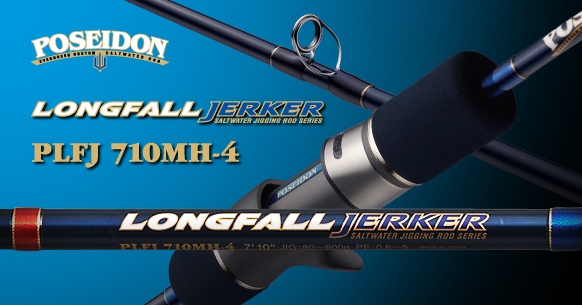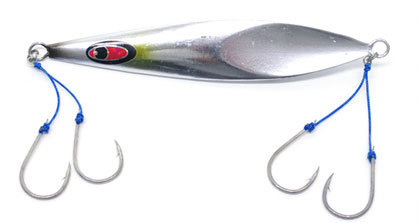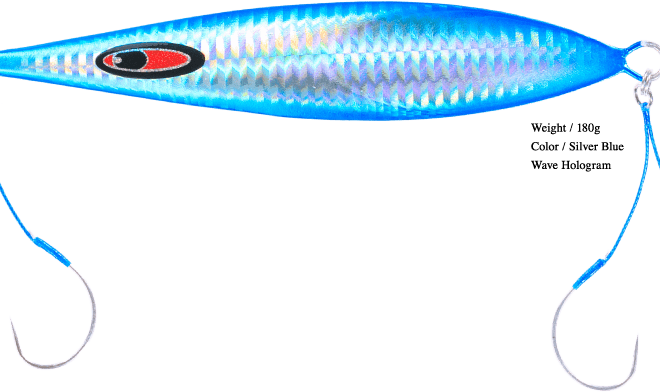Slow Jerker or Longfall Jerker?
6’3″ (192cm) Slow Jerker or 7’10” (238cm) Longfall Jerker?
This is a question people ask me sometimes when they are starting slow pitch game.
I think it’s also good to consider these models in comparison to understand this game more.
Let’s compare the specs first.
| Model | Length | Line | Jig Weight |
|---|---|---|---|
| Slow Jerker 603-3 | 191cm | PE2.0 | 60g – 150g |
| Slow Jerker 603-4 | 191cm | PE2.0 | 90g – 200g |
| Slow Jerker 603-5 | 191cm | PE2.5 | 120g – 250g |
| Slow Jerker 603-6 | 191cm | PE3.0 | 150g – 300g |
| Longfall Model | Length | Line | Jig Weight Range |
|---|---|---|---|
| Longfall Jerker 710ML-2 | 238cm | PE0.6-5.0 | 80g – 600g |
| Longfall Jerker 710M-3 | 238cm | PE0.6-5.0 | 80g – 600g |
| Longfall Jerker 710MH-4 | 238cm | PE0.6-5.0 | 80g – 600g |
| Longfall Jerker 710H-6 | 238cm | PE0.6-5.0 | 80g – 600g |
When you compare specs between these 2 rods without any knowledge of SPJ, Long Fall Jerker may look more versatile.
This is a huge misunderstanding. And a lot of people get confused on this. So, let me explain about the rod specs before getting down to the question.
First, let’s take a look at Slow Jerker about the line rating. Line rating is only an indication of how light or heavy it is in comparison with other models within the same make. It is never an indication on what line you should use. You have to pay more attention to the line rating with a casting rod. But not in the game of jigging.
Second, the jig weight indication is the same. This is not a casting game. It is never an indication of what jig weight you should use. You can use 40g and also 600g with any rod. The jig weight changes the Action Tone. That is what you should be aware of. The spec is just a comparison with other models.
>> What rod and jigs to buy first?
Now let’s take a look at Longfall Jerker. It lists the same line rating and the same jig weight for all models. This list is basically saying that these ratings are useless. It is saying, “if you want to choose a model, study slow pitch jigging and don’t look at the spec.”
But the model lists such as “medium light” and “medium heavy”. This is actually the appropriate attitude toward SPJ rods. As for Slow Jerker, we now take the last digit of the model number to call 603-3 “Power 3 rod” and 603-6 “Power 6 rod”. And this has become a standard for SPJ rod market.
All Longfall Jerker models are meant to be used in “soft action tone”. That is why all the model is rated for jig weight 80g to 600g. Different degrees, but all soft action tone.
It does not mean that Longfall Jerker is more versatile than Slow Jerker.
Long Fall Technique is all done in soft action tone. The rod doesn’t have to whip up. It’s a slow soft lift, a moment of pause at the top, and fall all the way down. That’s all. It needs to lift slow and soft because that will create the change of pace (COP) when the jig free-falls fast.
Which is better for the start?
Now, which is better, Slow Jerker or Longfall Jerker?
The answer is pretty obvious now, isn’t it?
I definitely recommend Slow Jerker, a slow pitch jigging rod.
You are starting. You are learning. You should practice different kinds of actions. You should experience different action tones. You should learn how to evaluate the water influence and set up the action tone purposefully. You should try different types of jigs.
You can learn more with a slow pitch rod. That’s the most important thing, I think, when you start your new game.
Long fall technique is indeed a part of slow pitch jigging. The idea is to maximize the falls. Of course you can do the same with slow pitch rod. But longer rod would make bigger falls. But because of its length, it’s hard to make little actions or punchy application. Long fall is a specialized rod. Also, it is not recommended with you are free-drifting.
The ocean is different everyday. Current changes every hour. Current is different in places too. Different fish. Different depth. Fish changes preferences by the tide, by the season, by the location.
You would want to change something when you are not catching. You want different tactics. You want to adapt to different conditions. And only you can do is to keep changing until you hit it.
Now with the slow pitch principles, you can make a difference by choosing from the unlimited combinations of the rod, line, leader, hook setting, action tones, and the jigs with different weights, types and colors.
You would learn more about these things with slow pitch rod.
And I strongly encourage to get 2 different models of slow pitch rods. Then the third rod can be a high pitch rod or a long fall rod. By then, you will know enough to choose what kind of tactics you would like to play and with what rod.
Related Posts
4 Comments
Leave a Reply Cancel reply
Categories
- 1. SPJ (57)
- 1-1. Principles (9)
- 1-2. Techniques (11)
- 1-3. Setup (17)
- 1-4. FAQ (19)
- 1-5. Tackles (3)
- 1-6. Video Gallery (2)
- 2. Other Offshore Games (5)
- 3. Fishing Report (105)
- 3-1. Totos (25)
- 3-2. Readers (72)
- 4. Fish Cooking (19)
- 4-1. Iki-Jime (3)
- 4-2. The Art of Sashimi (5)
- 4-3. Recipe (7)
- 4-4. Seasoning (3)
- 5. Fishing Charter (6)
- Fish (12)








Hi,toto-san
Im just wondering
Is spiral wrap guide a good choice for slow jigging?
Will there be any different from the conventional guide build for slow jig such as slow jerker rods?
Hi Wan.
I have tried the spiral guide in the field only once. I only got a 3kg size Trevally.
PROS. I think it was easy to ride the fish bite. When I make actions, I found it easy to control the tip movements. But I don’t know, maybe it’s the property of the blanks. I didn’t test the same blanks with the normal and the spiral. They say the sensitivity is better because of more small guides.
With spiral guide turning left toward the tip makes the line load toward to the left. I do line management with my left finger or thumb, so I found it easier.
CONS. I was a little nervous when I got the fish near the boat and it started running around. I felt the blanks twisted a little, which means power loss. One of the pros that they say is that the spiral guide prevents interference between the line and the blanks, but I thought that you should never lift the rod to fight.
It’s a subtle difference, I would say. And it’s up to your preference. For me personally, spiral guide is not a big factor when I choose my rods.
Hi
there is an error in the Long rods table. It is written 283cm in all the rods, but it actually is 238cm
Thank you for the correction. You are absolutely right!